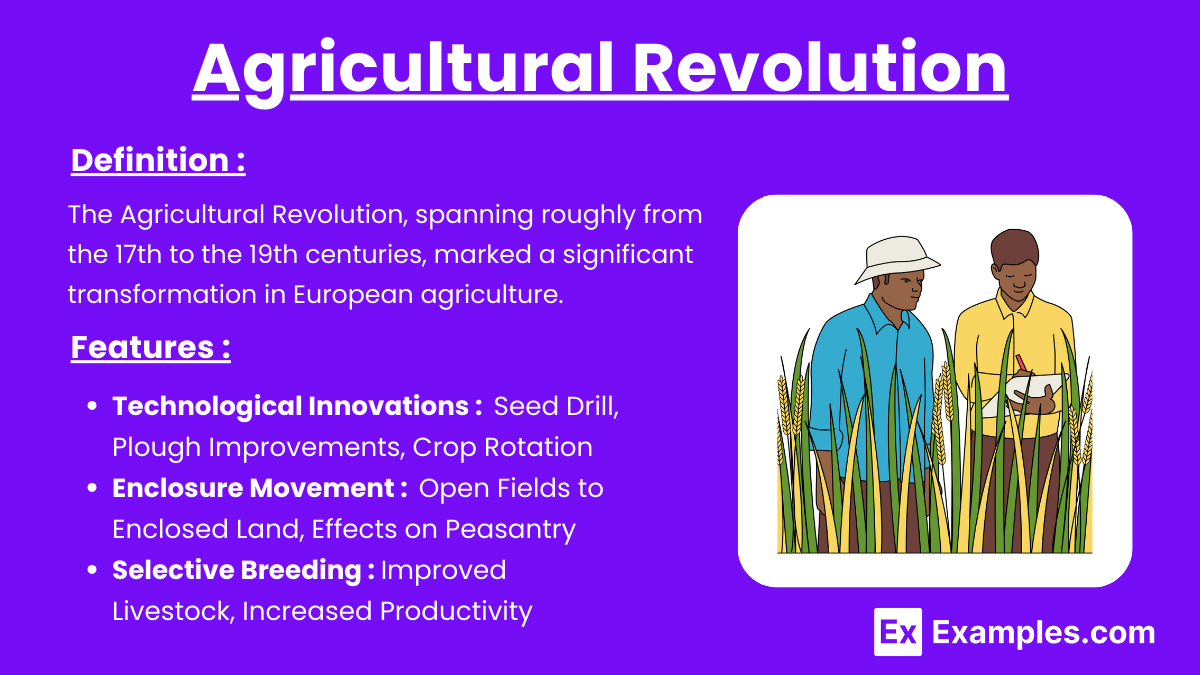The Agricultural Revolution, occurring in the 17th and 18th centuries, introduced innovations like the seed drill and crop rotation, significantly boosting crop yields. The Enclosure Movement transformed communal lands into private farms, increasing efficiency but displacing many peasants. This revolution led to surplus production, encouraging the growth of market economies through commercial farming and rural industries. The increased agricultural output also expanded trade networks and facilitated urbanization, laying the groundwork for the Industrial Revolution and transforming European social and economic structures.
Learning Objectives
In studying "The Agricultural Revolution and the Development of Market Economies" for the AP European History exam, you should focus on understanding the key innovations in farming techniques, such as the enclosure movement, crop rotation, and selective breeding. Learn about the introduction of new crops and their impact on European diets. Examine how these changes increased agricultural productivity, led to urbanization, and contributed to the rise of commercial agriculture. Additionally, explore the connection between agricultural advancements and the growth of market economies and industrialization in Europe.
Agricultural Revolution

The Agricultural Revolution, spanning roughly from the 17th to the 19th centuries, marked a significant transformation in European agriculture. This period saw the transition from traditional farming methods to more efficient and productive techniques. These changes not only revolutionized agricultural practices but also played a crucial role in the development of market economies in Europe.
Key Features of the Agricultural Revolution
1. Technological Innovations : The Agricultural Revolution saw the introduction of new farming equipment and methods:
Seed Drill: Invented by Jethro Tull, the seed drill allowed for the systematic planting of seeds in rows, improving germination rates and crop yields.
Plough Improvements: The introduction of the heavy plough, along with the Rotherham plough, made soil preparation more efficient, enabling farmers to cultivate more land.
Crop Rotation: The traditional three-field system was replaced by more advanced crop rotation systems, such as the Norfolk four-course rotation. This method alternated crops to maintain soil fertility and reduce fallow periods.
2. Enclosure Movement : The Enclosure Movement was a crucial aspect of the Agricultural Revolution:
Open Fields to Enclosed Land: Traditionally, land in England was farmed in open fields, shared by the community. Enclosures involved consolidating these lands into individually owned plots, which were then fenced off.
Effects on Peasantry: While enclosures allowed for more efficient farming, they also displaced many peasants, who lost access to common lands. This led to a migration of rural workers to urban areas, fueling the growth of cities and the labor force for the Industrial Revolution.
3. Selective Breeding : Selective breeding, also known as artificial selection, involved breeding animals with desirable traits to enhance productivity:
Improved Livestock: Selective breeding led to stronger, healthier animals, such as the famous Bakewell sheep and New Leicester sheep, which provided more meat and wool.
Increased Productivity: The practice significantly increased the size and quality of livestock, providing more resources for the burgeoning population.
Development of Market Economies

The Agricultural Revolution played a pivotal role in the development of market economies in Europe:
1. Surplus Production : The innovations of the Agricultural Revolution led to increased agricultural output, creating surplus production:
Commercial Farming: With more efficient farming practices, farmers could produce beyond their subsistence needs, allowing them to sell excess produce in local and regional markets.
Specialization: Farmers began to specialize in particular crops or livestock, optimizing their output and contributing to a more diverse market.
2. Rise of Rural Industry : The increased agricultural productivity supported the growth of rural industries:
Cottage Industries: With surplus food and raw materials, rural families could engage in cottage industries, such as weaving and pottery, supplementing their income.
Proto-Industrialization: This early phase of industrialization saw the rise of small-scale industries in rural areas, laying the groundwork for the later Industrial Revolution.
3. Expansion of Trade Networks : The surplus production and specialized farming led to the expansion of trade networks:
Local and Regional Markets: Farmers began to sell their surplus in local markets, which expanded into regional trade networks, linking rural and urban economies.
Global Trade: The increased agricultural output also contributed to global trade, as European nations exported surplus products to colonies and other regions.
4. Transformation of Social Structures : The Agricultural Revolution and the rise of market economies brought about significant social changes:
Landownership: The enclosure movement concentrated land ownership in the hands of a few wealthy landowners, altering the traditional feudal system.
Urbanization: Displaced rural workers migrated to cities, seeking employment in emerging industries. This urbanization trend was a key feature of the Industrial Revolution.
Impact on Market Economies
Increased Agricultural Productivity: Innovations like crop rotation and selective breeding boosted agricultural output, feeding growing urban populations and supporting industrialization.
Urbanization and Labor Shift: Efficient farming reduced the need for labor on farms, prompting migration to cities, which fueled urban growth and expanded industries.
Rise of Commercial Agriculture: Farmers shifted from subsistence to market-oriented production, contributing to the development of a capitalist economy.
Expansion of Trade and Markets: Increased production and commercialization expanded local and regional markets, promoting economic specialization and innovation.
Capital Accumulation and Investment: Profits from increased productivity allowed for capital accumulation, which was invested in new technologies, infrastructure, and industries, driving further economic development.
Examples of the Agricultural Revolution and Market Economies
Enclosure Movement: Consolidated land in England, increased productivity, and supported market growth.
Crop Rotation: Improved yields and soil health, leading to surplus and market expansion.
Agricultural Machinery: Tools like seed drills boosted efficiency and farm output, fostering markets.
Cash Crops: Shift to crops for sale (e.g., cotton, tobacco) promoted market development.
Trade Networks: Enhanced transportation and markets facilitated broader distribution and economic integration.
Practice Test Questions on Agricultural Revolution and Market Economies
Question 1:
Which of the following was a major impact of the Agricultural Revolution on market economies?
A) Decrease in food production
B) Increase in urbanization
C) Decline in trade networks
D) Reduction in population growth
Answer: B) Increase in urbanization
Explanation: The Agricultural Revolution led to significant advancements in farming techniques and productivity, which resulted in surplus food production. This surplus allowed populations to grow and more people to move to urban areas in search of jobs and better opportunities. As agriculture required fewer workers due to mechanization and improved methods, many people migrated to cities, leading to increased urbanization and the development of market economies.
Question 2:
How did the Agricultural Revolution contribute to the development of market economies?
A) By reducing the need for agricultural products
B) By centralizing agricultural practices in government hands
C) By promoting specialization and trade
D) By limiting technological innovations in farming
Answer: C) By promoting specialization and trade
Explanation: The Agricultural Revolution introduced new techniques and tools that increased agricultural productivity. This allowed farmers to produce more than they needed for their own consumption, creating a surplus. As a result, communities could specialize in particular products, fostering trade both locally and internationally. The surplus goods could be sold or traded, which was a foundational element for the development of market economies, where goods and services are exchanged in a more organized manner.
Question 3:
Which of the following is NOT a characteristic of market economies that emerged after the Agricultural Revolution?
A) Private property rights
B) Barter-based transactions
C) Supply and demand dynamics
D) Wage labor systems
Answer: B) Barter-based transactions
Explanation: Market economies are characterized by the use of currency for transactions, which replaced the earlier barter system. The Agricultural Revolution's increase in food production led to more complex economies where money became the primary medium of exchange. This shift facilitated easier and more efficient trade, allowing for the development of wage labor systems and the establishment of private property rights. Supply and demand dynamics also became more prominent as goods and services were traded based on their market value.


